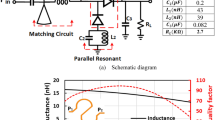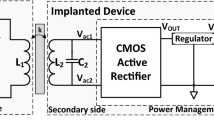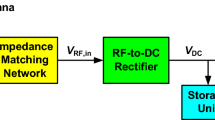Abstract
This paper presents a full-CMOS receiver for an A4WP application. Two schemes were used in the proposed synchronous rectifier to increase the efficiency of the rectifier. One scheme involves a limiting reverse current that senses the output load current by changing the half synchronous rectifier mode and full synchronous rectifier mode. Another scheme proposes a high efficiency active rectifier with a delay locked loop (DLL), which is a highly efficient receiver circuit intended for use in resonant wireless charging applications with a 6.78 MHz resonant frequency. Each metal-oxide-semiconductor field-effect transistor of the proposed rectifier uses an AC input voltage for the on/off operation. Concurrently, the DLL can compensate for the delay caused by the voltage limiter, level shifter, and gate driver, which leads to the removal of the reverse leakage current and maximizes the power efficiency. This chip is implemented using 0.18 μm technology with an active area of around 2.3 mm × 1.5 mm. When the magnitude of the AC input voltage is 10 V, the maximum efficiency of the proposed rectifier is 94.2 %. The range of AC input voltages is 3–20 V.



















Similar content being viewed by others
References
Wireless Power Consortium (2010). System description wireless power transfer. Volume I: Low power, Part 1: Interface Definition Version 1.0.
Lam, Y.-H., et al. (2006). Integrated low-loss CMOS active rectifier for wirelessly powered devices. IEEE Transactions on Circuits and Systems-II: Express Briefs, 53(12), 1378–1382.
Hashemi, S., Sawan, M., & Savaria Y. (2007). A novel fully-integrated dropless voltage CMOS rectifier for wirelessly powered devices. In IEEE Microelectronics, pp. 333–336.
Lee, H.-M., et al. (2012). An adaptive reconfigurable active voltage doubler/rectifier for extended-range inductive power transmission. IEEE Transactions on Circuits and Systems-II: Express Briefs, 59(8), 481–485.
Peters, C., Spreemann, D., Ortmanns, M., & Manoli, Y. (2008). A CMOS integrated voltage and power efficient AC/DC converter for energy harvesting applications. Journal of Micromechanics and Microengineering, 18(10), 104005.
Moon, Y.-J., et al. (2012) A 3.0-W wireless power receiver circuit with 75-% overall efficiency. In 2012 IEEE Asian Solid State Circuits Conference (A-SSCC).
Casanova, J. J., et al. (2009). Design and test of a high-power high-efficiency loosely coupled planar wireless power transfer system. IEEE Transactions on Industrial Electronics, 56(5), 1801.
Sira, D., Thomsen, P., & Larsen, T. (2010). Output power control in Class-E power amplifiers. IEEE Microwave and Wireless Components Letters, 20(4), 232–234.
Garate J. I., de Diego J. M., Perea S. P. (2006). Mixed RF output power control for low power transmitters in mobile cellular terminals. In Proceedings of IEEE International Symposium on Industrial Electronics (pp. 9–12). Montreal, Quebec, Canada.
Mohamed, El-N., et al. (2010). High PSR low drop-out regulator with feed-forward ripple cancellation technique. IEEE Journal of Solid-State Circuits, 45(3), 565–577.
Heng, S., et al. (2010). A low-power high-PSRR low-dropout regulator with bulk-gate controlled circuit. IEEE Transactions on Circuits and Systems-II: Express Briefs, 57(4), 245–249.
Guo, S., et al. (2009). An efficiency-enhanced CMOS rectifier with unbalanced-biased comparators for transcutaneous-powered high-current implants. IEEE Journal of Solid-State Circuits, 44(6), 1796–1804.
Shinoda, R., et al. (2012). Voltage-boosting wireless power delivery system with fast load tracker by ΔΣ-modulated sub-harmonic resonant switching, Solid-state circuits conference digest of technical papers. In IEEE International Solid-State Circuits Conference (ISSCC).
Acknowledgments
This work was supported by the National Research Foundation of Korea (NRF) grant funded by the Korean government (MSIP) (2014R1A5A1011478).
Author information
Authors and Affiliations
Corresponding author
Rights and permissions
About this article
Cite this article
Park, YJ., Park, HG., Lee, J. et al. A design of wide input range triple-mode active rectifier with peak efficiency of 94.2 % and maximum output power of 8 W for wireless power receiver in 0.18 µM BCD. Analog Integr Circ Sig Process 86, 255–265 (2016). https://doi.org/10.1007/s10470-015-0650-8
Received:
Revised:
Accepted:
Published:
Issue Date:
DOI: https://doi.org/10.1007/s10470-015-0650-8




